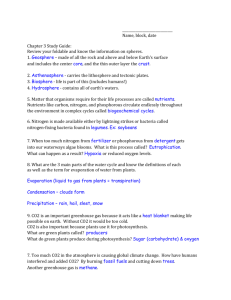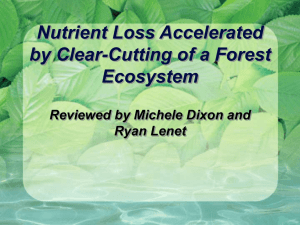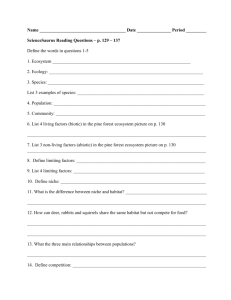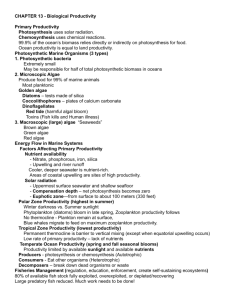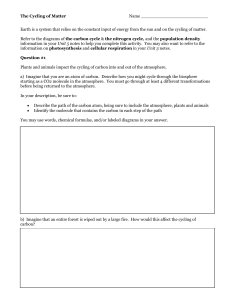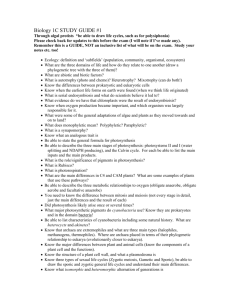Self-Quiz for Ecology Test 2 - Mercer Island School District
advertisement
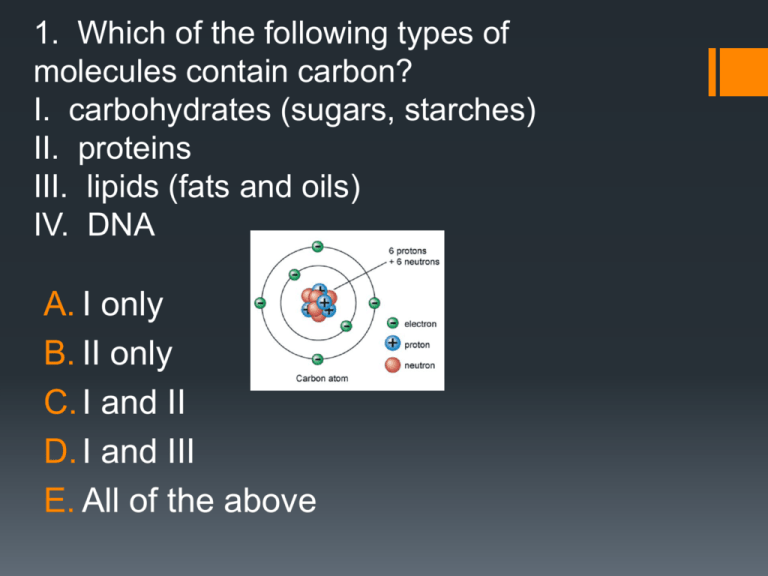
1. Which of the following types of molecules contain carbon? I. carbohydrates (sugars, starches) II. proteins III. lipids (fats and oils) IV. DNA A. I only B. II only C. I and II D. I and III E. All of the above 2. In photosynthesis, which of the following is/are produced? A.Carbon dioxide (CO2) B. Oxygen (O2) C. Glucose (C6H12O2) D. A and C E. B and C 3. As part of the carbon cycle, which process return carbon to the atmosphere in the form of carbon dioxide? A. Photosynthesis B. Cellular respiration C. Combustion (burning) D. A and C E. B and C 4. The amount of carbon dioxide in the atmosphere has been increasing. The second largest cause of this increase is ___. A. combustion of fossil fuels B. respiration C. deforestation D. photosynthesis 5. All living things require nitrogen to build certain organic molecules such as DNA. While the atmosphere is 78% nitrogen gas (N2) most organisms can not break the triple bond in this molecule. The process of converting N2 into usable nitrogen compounds (ammonia) is called. A. Combustion B. Denitification C. Nitrogen-fixing D. Degradation 6. What type of organism can perform nitrogen-fixing. A. Plants B. Certain bacteria that can live in the soil or in root nodules of certain plants C. Certain bacteria that live in hydrothermal vents. D. A and B E. B and C 7. Thermal pollution means an increase in ______________ in a body of water. It causes _______ in the oxygen concentration in the aquatic ecosystem. A. Heat; increase B. Heat; decrease C. Nutrients; increase D. Nutrients; decrease The solubility of gases decreases as the temperature increases. More likely to come out of solution at higher temperatures. Soda goes flat (loses dissolved gas) as it gets warm 8. Eutrophication means _________ nutrient levels (nitrogen, phosphorus, organic matter) in an aquatic ecosystem. It results in _______________ oxygen levels in the water. A. high ; low B. high; high C. low; low D. low; high 9. The reason that eutrophication results in low oxygen levels is that A. The nutrients cause an overgrowth of algae to occur B. Excessive photosynthesis by the algae occurs C. Decomposers deplete (use up) the oxygen D. A and B E. A and C F. A, B and C Review: Remember the irony of eutrophication. High nutrient levels – from fertilizer runoff, farm waste, septic runoff- causes an overgrowth of algae because the increase in the typically limiting nutrients of nitrogen and phosphorus allow for greater algae growth. Algae is photosynthetic so you might expect oxygen levels to increase. However, fast growing algae can block sunlight. As the algae and other aquatic plants die, the decomposers use oxygen causing the oxygen levels to drop. Lake with eutrophication may have fish kills when the oxygen level becomes too depleted for some fish species. 10. A temperate forest with deciduous trees has ________ temperatures and trees that ___________ . A.extreme temperatures; have cones. B. extreme temperatures; lose their leaves C. moderate temperatures; have cones D. moderate temperatures; lose their leaves 11. The process by which plants lose water from their leaves is called A.Perspiration B.Infiltration C.Percolation D.Transpiration 12. A change in a region over time, with a changing composition of plants, is called A.Progression B. Evolution C. Succession D. Adaptation E. B and D 13. After a forest fire which destroys most vegetation, but leaves some organic matter in the ecosystem, which type of succession occurs? A.Primary B.Secondary C.Tertiary 14. Which of the following biomes generally has the highest biodiversity (greatest number of different species)? A.Temperate deciduous forest B.Taiga (Boreal forest) C.Tropical rainforest D.Grasslands E.Tundra 15. The chemical equation for photosynthesis is A. C6H12O6 + 6 CO2 6 O2 + 6 H2O B. C6H12O6 + 6 O2 6 CO2 + 6 H2O C. 6 CO2 + 6 H2O 6 O2 + C6H12O6 D. 6 O2 + 6 H2O 6 CO2 + C6H12O6 16. A species of tropical bird follows army ants in the forest. These birds eat insects that have escaped from the colony of army ants as it moves through the forest (not the army ants themselves). Which type of symbiotic relationship is this between these birds and the army ants? A. Mutualism B. Commensalism C. Parasitism 17. Which type of symbiotic relationship is found between a flower and its pollinator? A.Mutualism B.Commensalism C.Parasitism 18. The role an organism plays in an ecosystem is part of its A. habitat B. niche C. both A and B D. neither A nor B 19. Soil erosion (the loss of soil especially by wind and water) is increased by A. Tilling fields B. Removing vegetation (plants) C. Both A and B D. Neither A nor B 20. An species that is brought to a new ecosystem may become invasive because A. It may not have any predators in the new ecosystem B. May start to reproduce at a higher rate C. It may breed with native species 1. E 2. E 3. E 4. C 5. C 6. B 7. B 8. A 9. E 10.D 11.D 12.C 13.B 14.C 15.C 16.B 17.A 18.B 19.C 20.A
